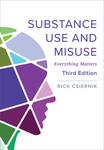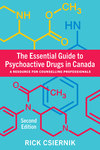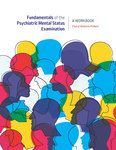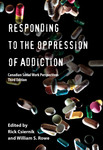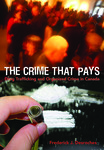We don’t actively support Internet Explorer
It appears that you are using Internet Explorer, which has been discontinued by Microsoft. Support has ended for versions older than 11, and as a result you may face security issues and other problems when using it.
We recommend upgrading to a newer browser such as Firefox, Google Chrome, or Edge for a much better experience across the web.
While this site may work with Explorer, we are not testing and verifying it, so you may run into some trouble or strange looking things.
The Drug Paradox
An Introduction to the Sociology of Psychoactive Substances in Canada
By Tara Bruno, Rick Csiernik
Overview
Why are some drugs considered socially acceptable while others are demonized? What makes these definitions so widespread? Who benefits from these conceptualizations? The Drug Paradox examines both the empirically founded and the socially constructed facets of drugs and drug use, highlighting the incongruous aspects of laws, policies, and programming that aim to address behaviours around drugs. The authors explore this paradox, arguing that Canada’s punitive approach to addressing drug use continues to exist alongside harm-reduction strategies and that these competing approaches ultimately impede Canada’s ability to deal effectively with substance misuse.
Using a policy-oriented approach while also emphasizing the utility of a multifaceted biopsychosocial model, this text provides students with a foundation in the sociology of psychoactive substances in the Canadian context. It covers a broad range of issues—models of addiction, the history of Canada’s drug laws, media representation, government responses to substance use, and international perspectives on drug policy—and addresses various research areas that are important for students to consider when trying to make sense of the competing discourses on drugs in society. This timely textbook is ideal for use in sociology courses on drugs or drug use and will also appeal to those focusing on drug use from a criminology, public health, cannabis studies, or policy perspective.
Features
- evaluates drugs and their use in Canadian society through a sociological lens
- provides an up-to-date discussion of both legal and illegal drugs
- each chapter includes a list of paradoxes and critical reflection questions
Table of Contents
Table of Contents Preface xiii
Acknowledgements xvi
Chapter 1: The Drug Paradox: Canada’s Conflicting Approaches to Drugs and Drug Users 1
1.1 What Is the Drug Paradox? 1 1.2 Defining the Core Concepts 4 1.3 The Social Reality of Drugs and Drug Use 10
Chapter 2: The History and Politics of Canada’s Drug Laws 15
2.1 Prohibition Era 16 2.2 The Opium Act (1908) 17 2.3 Proprietary or Patent Medicine Act (1908) 19 2.4 The Opium and Drug Act (1911) 20
2.5 The Opium and Narcotic Drug Act (1929) 21
2.6 The Narcotic Control Act (1961) 23 2.7 Controlled Drugs and Substances Act (1996) 25 2.8 Marihuana for Medical Purposes Regulations (2013) 26 2.9 Access to Cannabis for Medical Purposes Regulations (2016) 27 2.10 A Framework for the Legalization and Regulation of Cannabis in Canada (2016) 27 2.11 Conclusion 28
Chapter 3: Explaining Substance Use I: Biological and Psychological
Theories 31
3.1 The Moral Model Versus the Medical Model 32 3.2 Biological Explanations 35
Nature and Drive Theories Genetic Theories Neurobiological Theories
3.3 Psychological Explanations 41
Personality Theories Behavioural Theories Psychopathology
3.4 Conclusion 48
Chapter 4: Explaining Substance Use II: Sociological Theories 50
4.1 Control Theories 51
Social Bonding Theory
Self-Control Theory
4.2 Strain Theories 54
Anomie/Strain Theory
General Strain Theory
4.3 Subcultural Theories 57
Labelling Theory
Differential Association Theory
Social Learning Theory (Differential Association-Reinforcement Theory)
4.4 Integrated Explanations of Substance Use 62
Differential Opportunity Theory
Drift Theory
Routine Activities and Lifestyle Theories
4.5 Conflict Theories 65
Marxian Conflict Theory Pluralist Conflict Theory
4.6 Postmodern Explanations 68
Normalization Thesis
Foucault and Biopower
4.7 Conclusion 73
Chapter 5: Classifying Drugs: Psychopharmacological Properties and
Legal Classifications 76
5.1 What Is Psychopharmacology and Why Does It Matter to Sociologists? 77
5.2 Opioids (Narcotics) 79
Natural Opioids
Semi-Synthetic Opioids
Synthetic Opioids
Legal Classification and Penalties for Opioids
5.3 Depressants 89
Alcohol Barbiturates Benzodiazepines Inhalants/Solvents
Legal Classification and Penalties for Depressants
5.4 Stimulants 94
Cocaine
Amphetamines (Including Methamphetamine)
Nicotine
Caffeine
Legal Classification and Penalties for Stimulants
5.5 Hallucinogens 101
Natural Hallucinogens
Semi-Synthetic Hallucinogens
Synthetic Hallucinogens
Legal Classification and Penalties for Hallucinogens
5.6 Cannabis (Marijuana) 106
Legal Classification and Penalties for Cannabis
5.7 Psychotherapeutic Agents and Performance-Enhancing
Drugs 108
Psychotherapeutic Agents
Performance-Enhancing Drugs
Legal Classification and Penalties for Psychotherapeutic Agents and
Performance-Enhancing Drugs
5.8 The Problem with Drug Effects and Legal Classifications 113
Chapter 6: The Socially Constructed Problem of Drugs and Drug
Users 115
6.1 Bath Salts 116 6.2 Ecstasy 117 6.3 Crystal Meth 118 6.4 Cocaine 120 6.5 Prescription Stimulants: Attention-Enhancing Prescription Drugs 123 6.6 Cannabis 124 6.7 Solvents/Inhalants 126 6.8 Prescription Opioids 127 6.9 Heroin 128 6.10 Hallucinogens 129 6.11 Bringing Together the Objective and Subjective Realities 131
Chapter 7: Studying Substance Use 133
7.1 Population-Based Studies 133
International Studies National Studies Provincial/Regional Studies
Advantages and Disadvantages of Population-Based Studies
7.2 Field-Based Studies 140
In-Depth Interviews Focus Groups Ethnographies
Advantages and Disadvantages of Field-Based Studies
7.3 Clinical Population Studies 145
Treatment Studies
Correctional Populations
Advantages and Disadvantages of Clinical Population Studies
7.4 Indigenous Methodological Approaches 150
7.5 Conclusion 152
Chapter 8: Demographic Correlates of Substance Use in Canada 155
8.1 General Prevalence Rates of Substance Use in Canada 156 8.2 Demographic Correlates 158
Age
Sex
Ethnicity and Race Socioeconomic Status (SES) Geographic Location
8.3 Conclusion 172
Chapter 9: Relational Correlates of Substance Use in Canada: Peers and
Families 174
9.1 Peers 175
Perceived Peer Use Versus Actual Peer Use
Social Activities and Peers
Selection of Peers
Intimate Partners
9.2 Families 179
Sibling Influence Parental Influences Parental Substance Use
9.3 Conclusion 187
Chapter 10: Prevention Strategies for Drugs and Potential Drug Users in
Education 189
10.1 Types of Prevention in Education 190
Universal Prevention Selective Prevention Indicated Prevention
10.2 Drug Education in Schools 192 10.3 Models of Drug Education 196
Information/Knowledge Models Values/Decision-Making Models Social Competency Models
Harm Minimization/Harm Reduction Models
10.4 Drug Educators: Teachers and Police 198
10.5 Ontario: The Case of Failed Drug Education 200
10.6 Future of Drug Education: The Good and the Bad 202
Chapter 11: Legal Responses to Drugs and Drug Users 208
11.1 Prohibition 210
Advantages and Disadvantages of Prohibition
11.2 Decriminalization 217
Advantages and Disadvantages of Decriminalization
11.3 Legalization 220
Free-Market Legalization
Limited-Distribution Legalization
Medical Legalization
Advantages and Disadvantages of Legalization
11.4 Conclusion 229
Chapter 12: International Drug Policies 233
12.1 International Drug Conventions 234 12.2 Punitive Policies 236
Russia China Iran
12.3 Pragmatic Policies 240
Portugal Netherlands Uruguay
12.4 Conclusion 245
Chapter 13: Canada’s Drug Policies 247
13.1 Advocates for Punitive Approaches 249 13.2Advocates for Pragmatic Approaches 250 13.3 What Is the Official Approach to Drugs and Drug Use in Canada? 251 13.4 The Missing Component in Canada’s Current National Anti-Drug Strategy: Harm Reduction 255
13.5 The Future 259
Appendix A: Canadian Cannabis Legalization Highlights (by Province/Territory) 262
References 264
Index 300


